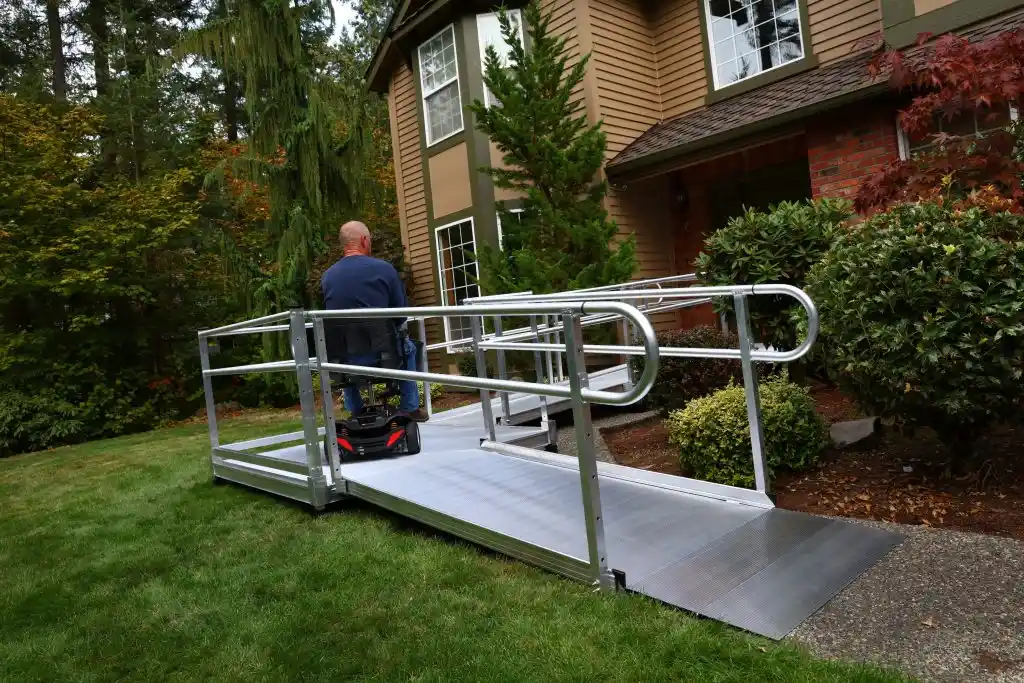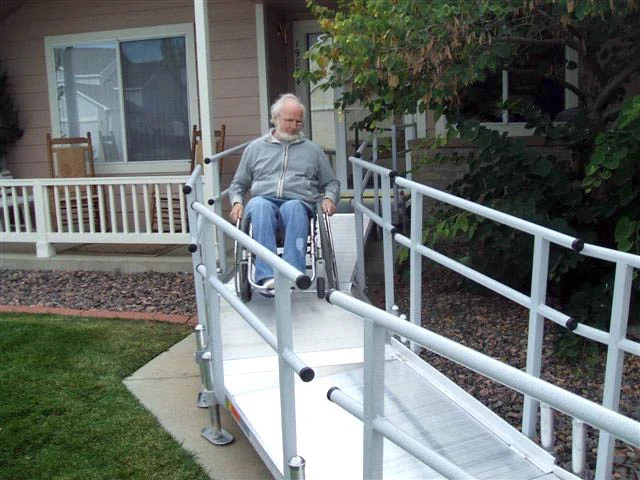As our population continues to age, ensuring the safety and well-being of elderly individuals becomes a top priority. One area where safety features are crucial is in the design and construction of home ramps. These ramps not only provide a convenient means of accessing different areas of the home for those with limited mobility but also offer important safety features that promote independence and peace of mind. By exploring the various aspects of these safety features, such as their sturdiness, non-slip surfaces, and handrails, we can begin to understand how home ramps revolutionize the way elderly individuals maintain their mobility and independence.
But what exactly are these safety features, and how do they empower the elderly on their journeys? Let’s take a closer look.
Key Takeaways
- Safety features in home ramps are crucial for ensuring the well-being and security of elderly individuals.
- Home ramps with safety features such as handrails, non-slip surfaces, and edge protection minimize the risk of accidents and provide a safe environment for seniors.
- Home ramps enhance mobility and overall quality of life for elderly individuals by eliminating the need for stairs, accommodating assistive devices, and promoting autonomy and freedom.
- Proper installation and maintenance of safety features for home ramps are essential for ensuring the well-being and security of individuals with mobility limitations.
Importance of Safety Features
Why are safety features in home ramps crucial for ensuring the well-being and security of elderly individuals? As we age, our mobility may become limited, making it essential to have safe and accessible environments within our homes. Home ramps are a common solution that allows elderly individuals to navigate their homes safely and independently. However, it is important to ensure that these ramps are equipped with the necessary safety features to prevent accidents and injuries.
One of the most crucial safety features in home ramps is a non-slip surface. Elderly individuals may have decreased stability and balance, making it easier for them to slip and fall. A non-slip surface, such as a textured or rubberized material, provides traction and reduces the risk of accidents.
Another important safety feature is handrails. Handrails offer stability and support while navigating the ramp. They provide a means for individuals to steady themselves and maintain their balance, especially when ascending or descending the ramp.
Additionally, it is important to consider the width and slope of the ramp. A wider ramp allows for easier maneuverability, especially for individuals using mobility aids such as walkers or wheelchairs. The slope should be gentle enough to prevent strain and fatigue while still allowing for easy navigation.
Types of Safety Features
There are several key safety features that can be incorporated into home ramps to ensure the well-being and security of elderly individuals. These features are designed to minimize the risk of accidents and provide a safe and comfortable environment for seniors to navigate their homes. Here are four types of safety features commonly found in home ramps:
- Handrails: Handrails provide stability and support while ascending or descending the ramp. They allow seniors to maintain their balance and can prevent falls or slips. Handrails should be installed on both sides of the ramp and be of a comfortable height for gripping.
- Non-Slip Surface: A non-slip surface is essential to prevent accidents caused by slippery conditions. It ensures that the ramp remains safe to use even in wet or icy weather. Non-slip surfaces can be achieved through the use of textured materials or the application of non-slip coatings.
- Edge Protection: Edge protection features, such as raised edges or guardrails, prevent wheelchair wheels from accidentally rolling off the ramp. This feature adds an extra layer of security and helps to keep users safely on the ramp.
- Lighting: Adequate lighting is crucial for visibility, especially in low-light conditions. Installing lighting along the ramp ensures that seniors can see any potential hazards and navigate the ramp with confidence.
Benefits of Home Ramps
Home ramps offer a multitude of benefits for elderly individuals, enhancing their mobility and overall quality of life. These ramps provide a safe and convenient solution for individuals with limited mobility, allowing them to move freely in and out of their homes without any barriers or obstacles.
One of the key benefits of home ramps is that they eliminate the need for stairs, which can be challenging and risky for elderly individuals. Ramps provide a smooth and gradual incline, making it easier for individuals with mobility issues to navigate. This not only reduces the risk of falls and accidents but also promotes independence and self-confidence.
Additionally, home ramps are designed to accommodate various assistive devices such as wheelchairs, walkers, and canes. This means that individuals can easily move around their homes without the need for assistance, promoting a sense of autonomy and freedom.
Furthermore, home ramps can be customized to suit individual needs and preferences. They can be built to the desired length, width, and slope, ensuring optimal safety and accessibility. This customization allows individuals to have ramps that seamlessly blend with the aesthetic of their homes, creating a sense of belonging and pride.

Factors to Consider in Choosing Home Ramps
To ensure the best choice in home ramps, individuals should carefully consider several important factors:
- Accessibility: Assess the specific needs of the individual who will be using the ramp. Consider their mobility limitations and the type of mobility device they use. Ensure that the ramp provides a safe and smooth transition between the different levels of the home.
- Safety Features: Look for ramps that have safety features such as handrails, non-slip surfaces, and edge protection. These features will provide additional support and prevent accidents or falls.
- Durability: Choose a ramp that is made from high-quality materials and is built to withstand various weather conditions. This will ensure that the ramp remains in good condition for a long time and requires minimal maintenance.
- Installation and Portability: Consider the ease of installation and whether the ramp can be easily moved or adjusted as needed. Portable ramps can be beneficial for individuals who may need to travel or relocate.
Installation and Maintenance of Safety Features
The proper installation and regular maintenance of safety features in home ramps are crucial for ensuring the well-being and security of individuals with mobility limitations. When it comes to installing safety features, it is important to follow the manufacturer’s guidelines and instructions. This includes ensuring that the ramp is securely anchored to prevent any movement or instability. Additionally, handrails should be installed on both sides of the ramp to provide stability and support for users.
Regular maintenance is equally important in ensuring the effectiveness of safety features. This includes inspecting the ramp for any signs of wear and tear, such as loose bolts or cracked surfaces, and addressing them promptly. It is also important to keep the ramp clear of any debris or obstacles that could pose a tripping hazard.
In addition to installation and maintenance, it is essential to educate users on how to safely navigate the ramp. This includes teaching proper techniques for ascending and descending the ramp, as well as ensuring that individuals are aware of their own limitations and use any necessary mobility aids, such as walkers or canes.
Enhancing Mobility and Independence
By incorporating safety features into home ramps, individuals with mobility limitations can experience enhanced mobility and increased independence. Home ramps are designed to provide a smooth and secure transition between different levels, allowing individuals to move freely and safely within their own homes. These safety features not only promote mobility but also empower individuals to maintain their independence by eliminating barriers and reducing the risk of accidents.
Here are four key ways in which safety features in home ramps enhance mobility and independence:
- Slip-resistant surfaces: Home ramps are equipped with slip-resistant surfaces to ensure traction and prevent slips and falls. This feature is particularly important for individuals with limited mobility or balance issues.
- Handrails and grab bars: Handrails and grab bars are strategically placed along the ramp to provide support and stability. These features enable individuals to navigate the ramp with confidence and reduce the risk of falls.
- Ramp width and incline: Safety regulations dictate that home ramps should be wide enough to accommodate mobility aids, such as wheelchairs or walkers. Additionally, the incline of the ramp should be gradual to minimize exertion and enhance accessibility.
- Visible markings and lighting: Clear markings and adequate lighting are essential for individuals with visual impairments. These features help individuals navigate the ramp safely and independently, even in low-light conditions.
Frequently Asked Questions
Are Home Ramps the Only Safety Feature for Ensuring Elderly Mobility?
No, home ramps are not the only safety feature for ensuring elderly mobility. Other important safety features include grab bars, non-slip flooring, handrails, and proper lighting. These features work together to create a safe and accessible environment for elderly individuals.
How Do Safety Features in Home Ramps Contribute to the Overall Safety of Elderly Individuals?
Safety features in home ramps play a crucial role in ensuring the overall safety of elderly individuals. These features include non-slip surfaces, handrails, and proper inclines, all designed to prevent falls and provide a secure and accessible environment for mobility.
Are There Any Specific Safety Features That Are Recommended for Home Ramps?
Yes, there are specific safety features recommended for home ramps. These may include non-slip surfaces, handrails on both sides for support, proper lighting for visibility, and a gentle slope to prevent accidents.
What Are the Potential Benefits of Using Home Ramps With Safety Features?
Using home ramps with safety features provides numerous benefits for elderly mobility. These features ensure stability, prevent slips and falls, and promote independence. By incorporating safety measures, home ramps empower seniors to navigate their surroundings with confidence and reduced risk of accidents.
How Can Individuals Ensure Proper Installation and Maintenance of Safety Features in Home Ramps?
To ensure proper installation and maintenance of safety features in home ramps, individuals should consult with experts or professionals in the field. They can provide guidance on the best practices to follow, ensuring the ramps are safe and secure for elderly mobility.
Conclusion
In conclusion, home ramps equipped with safety features play a crucial role in ensuring the safety and well-being of the elderly population. These ramps provide convenient access to different areas of the home while promoting independence and mobility.
By focusing on sturdy construction, non-slip surfaces, and handrails, home ramps empower elderly individuals to navigate their living spaces with ease and confidence. With the ability to maintain mobility and independence, the elderly can remain active and engaged in their surroundings, enhancing their overall quality of life.
You may also like to read:
Empowering Women in Real Estate: Financing Strategies for Success



